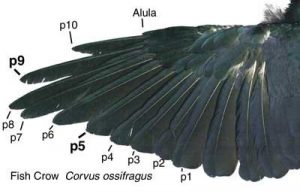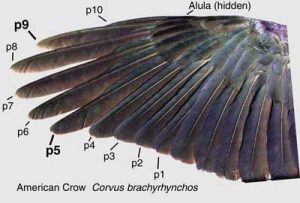I spy a crow flying overhead, straight and steady, obviously heading to a destination; “as a crow flies.” I attempt an identification and wait for the crow to call. Uh-uh, no luck this time. Isn’t a crow a crow?
Most people do not realize that in the United States (including Hawaii) there are possibly five species of crow. Most birders struggle to tell the difference between the various species of crows. In the area where I live, the eastern United States, we have two species, the American crow, Corvus brachyrhynchos, and the fish crow, Covus ossifragus. The word Corvus is Latin for crow or raven, simple enough. Ossifragus is Latin for bone-breaking.1 I am not sure of the reasoning, but it is interesting to note that the ossifragus also means osprey or sea eagle.2 As their name implies, fish crows, like osprey and bald eagle, prefer being near water.
Since they look very similar, crows create a challenge for field identification. The different sounds they make provide the best identification feature. Those who recognize the difference should have caught the pun earlier. The fish crow calls a nasal two noted uh-uh sound (the link will take you to a web page where you need to click on listen). The America crow makes the far more familiar caw, caw, caw sound. These sounds are diagnostic for the respective species. During the spring from March to May, one must be a little careful as a begging female and young American crows makes a nasal sound. Usually associated with a bird on or near a nest.5 Most times, the difference is apparent enough not to be confusing. Most birders watch, wait, and hope that the crow they observe makes a sound. Fortunately, crows tend to be loquacious , yakking up a storm. What is one to do if the crow remains mute? Subtle morphological differenced do exist and with practice one can separate some of the flying or standing birds.
It may seem trivial, but in American crow, the primary wing feather called the P5 is markedly longer than the P9 (see photograph for comparison). For the fish crow, the primary feathers P5 and P9 are similar in size, or P9 is slightly longer. 3 If you think of the wing of the crow as a hand, palm down, the p5 to P10 would be the fingers. P10 would be the thumb, so P9 would be your index finger and P5 your pinky. In an American crow, the pink is as longer than the index finger. This serves to give the fish crow a more pointed look to its wing and the American crow a more rounded wing.

http://www.birds.cornell.edu/crows/images/fcrowing.jpg

http://www.birds.cornell.edu/crows/images/Amcrowing.jpg
Furthermore, the fish crow wing, unlike the American crow wing, thins a little at the body. The end result is a slightly different shape to the wing giving the fish crow a longer-tailed look. One must be careful as birds wings look different depending upon a myriad of conditions ranging from flight position to wind.
The fish crow, being slightly smaller than the American crow beats its wings faster during normal flight. Both species beat their wings hard when climbing or when they accelerate, so this can best be used as they leisurely they fly overhead.
On the ground, one may be able to notice the difference in size. The total length of a fish crow ranges from 14 inches to 15.75 inches. The total length of the American crow ranges from 17 inches to 21 inches. Size is a very difficult measurement to judge in the field. When standing, the American crow has longer legs, once again something best seen when the two birds are standing next to each other.
In summary, a person bound and determined to sort through the difference between these two look alike birds needs to spend many hours looking at hundreds if not thousands of birds. Very few of the birds will cooperate by calling, but with careful study, one may be able to sort out some, but I doubt anyone can do all of the crows.
- Borror, Donald, Dictionary of Word Roots and Combining Forms, Mayfield Publishing Company, Palo Alto, CA, 1971.
- https://en.wiktionary.org/wiki/ossifragus
- McGowan, Kevin J.. (2001). Fish Crow (Corvus ossifragus), The Birds of North America (P. G. Rodewald, Ed.). Ithaca: Cornell Lab of Ornithology; Retrieved from the Birds of North America: https://birdsna.org/Species-Account/bna/species/fiscro
- Verbeek, N. A. and C. Caffrey. (2002). American Crow (Corvus brachyrhynchos), The Birds of North America (P. G. Rodewald, Ed.). Ithaca: Cornell Lab of Ornithology; Retrieved from the Birds of North America: https://birdsna.org/Species-Account/bna/species/amecro DOI: 10.2173/bna.647
- Excellent resource: http://www.birds.cornell.edu/crows/FishCrow.htm
Sounds came from All About Birds website, a great resource for learning about bird species, or from the Cornell’s bird song collection.
Note: I said, “…possibly five species…” because the Hawaiian crow, Corvus hawaiiensis, is presumed extinct. The northwestern crow, Corvus caurinus, is considered by some to be a subspecies of the American crow. Finally, the Tamaulipas crow, Corvus imparatus, a bird restricted to the Brownsville, TX area, has become very rare in the US with the last reported nesting in 2001.*
